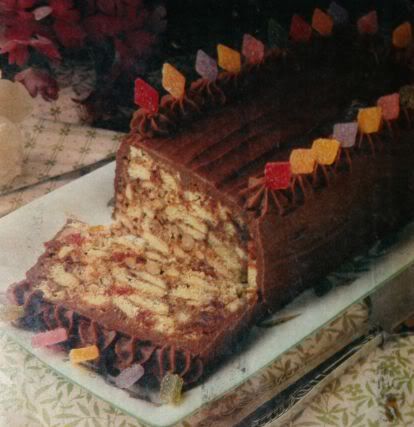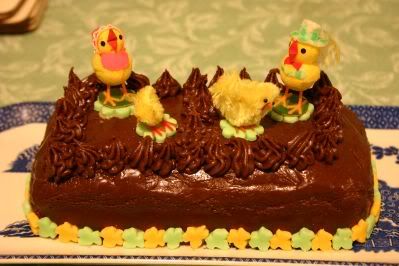Malted Chocolate Biscuit Loaf
An odd post for me, but... as requested...
Malted Chocolate Biscuit Loaf
For some family reason that has yet to be fathomed, I always make this for Easter...

This is quite exceptionally sweet, so not to everyone's taste - but kids usually love it, as do adults if you can persuade them to indulge. :)
It's not a cake, but biscuit based, so there's no baking involved (unless you want/need to make your own biscuits).
Update!
Right, I've made this years cake - so I'll add a picture of it. The decorations are standing on little green fondant petals, and the base edge is trimmed with yellow/green fondant leaves. The chicken models we've had for years...

Ingredients
Loaf
175g (7oz) rich tea biscuits [see notes]
100g (4oz) glace cherries
4x15ml (4tbsp) golden syrup [light corn syrup will do]
75g (3oz) margarine
4x15ml (4tbsp) malted chocolate drink powder [Ovaltine, or Milo, or 3tbsp Horlicks + 1tbsp cocoa powder]
Icing
100g (4oz) plain chocolate-flavour cake covering [see notes]
50g (2oz) margarine
1 egg (medium)
150g (6oz) icing sugar [confectioner's sugar]
diamond-shaped sugar jellies
Method
1. Line the long sides and base of a 1lb loaf tin with a length of foil, overlapping each rim by 5cm (2in). Grease foil and tin.
2. Place biscuits in a food bag, or between two sheets of greaseproof paper, and roll gently with a rolling pin until well broken, not crushed (I find small pieces make the loaf easier to cut). Chop glace cherries into quarters.
3. Measure golden syrup carefully, levelling off spoon with a knife and scraping excess from underside of spoon. Place in a saucepan with margarine. Heat gently until margarine melts, remove pan from heat and stir in malted chocolate quickly.
4. Add biscuits and cherries, stir until well mixed. Place in loaf tin, pressing down with a back of a metal spoon to level the top. Bring foil over to cover the top and chill until set (best to leave it at least 1/2 day).
5. To make the icing; break up chocolate and place in a basin with margarine over a saucepan of hot, but not boiling, water. Stir occasionally until melted. ightly beat the egg, and beat it quickly in to the chocolate mixture. Remove basin from saucepan - don't allow the egg to cook at all.
6. Sift icing [confectioner's] sugar and gradually beat into chocolate mixture (use an electric whisk). Beat well. Leave to cool until icing begins to thicken. Place a rounded tablespoon into a piping tube with a star-shaped nozzle.
7. Fold back foil and invert cake on to a serving plate. Spread main bulk of icing over top and sides of cake using a small palette knife to cover evenly. Pipe a row of stars around the top.
8. Arrange diamond jelly shapes along the top, one in each icing star.
9. Leave to set.
Notes
a) If you can't get plain cake covering, which is often a lot sweeter than pure dark chocolate, then use pure dark chocolate and add a tablespoon of golden syrup to the icing, then possibly add some more sifted icing sugar to the icing - taste it to get it to how sweet you like it.
b) As with all recipes, follow one set of measurements only. Don't mix imperial and metric measurements, that won't work well.
c) As I can't use malted chocolate drinks anymore, I'm planning on replacing the 4tbsp of that powder with 1 1/2 tbsp of cocoa, and replacing 1tbsp of golden syrup with 2tbsp of malt extract - crushing some of the biscuits to powder to compensate for the lack of powder. Also, you could use 3tbsp hot chocolate powder and add 2tbsp of malt extract in place of 1tbsp syrup.
d) The egg in the icing keeps it soft and silky, if you don't want uncooked egg in your icing then it can probably be omitted (especially if you've put some golden syrup in the icing, as above), probably best to add 1 tbsp of milk to the chocolate mixture to make up for the lost liquid.
e) It's essentially a soft chocolate fudge icing, and you could conceivably buy pre-made fudge frosting to top the loaf.
f) Rich Tea Biscuits seem to be peculiar to Britain, judging by the number of ex-patriot websites that stock them they must be hard to get in the US. They are a type of dry, slightly malted biscuit (cookie) - it is possible to make your own, if anyone needs that [like anyone is going to make this] - I'll post it. Does anyone know of an american equivilent that'd work?
Malted Chocolate Biscuit Loaf
For some family reason that has yet to be fathomed, I always make this for Easter...

This is quite exceptionally sweet, so not to everyone's taste - but kids usually love it, as do adults if you can persuade them to indulge. :)
It's not a cake, but biscuit based, so there's no baking involved (unless you want/need to make your own biscuits).
Update!
Right, I've made this years cake - so I'll add a picture of it. The decorations are standing on little green fondant petals, and the base edge is trimmed with yellow/green fondant leaves. The chicken models we've had for years...

Ingredients
Loaf
175g (7oz) rich tea biscuits [see notes]
100g (4oz) glace cherries
4x15ml (4tbsp) golden syrup [light corn syrup will do]
75g (3oz) margarine
4x15ml (4tbsp) malted chocolate drink powder [Ovaltine, or Milo, or 3tbsp Horlicks + 1tbsp cocoa powder]
Icing
100g (4oz) plain chocolate-flavour cake covering [see notes]
50g (2oz) margarine
1 egg (medium)
150g (6oz) icing sugar [confectioner's sugar]
diamond-shaped sugar jellies
Method
1. Line the long sides and base of a 1lb loaf tin with a length of foil, overlapping each rim by 5cm (2in). Grease foil and tin.
2. Place biscuits in a food bag, or between two sheets of greaseproof paper, and roll gently with a rolling pin until well broken, not crushed (I find small pieces make the loaf easier to cut). Chop glace cherries into quarters.
3. Measure golden syrup carefully, levelling off spoon with a knife and scraping excess from underside of spoon. Place in a saucepan with margarine. Heat gently until margarine melts, remove pan from heat and stir in malted chocolate quickly.
4. Add biscuits and cherries, stir until well mixed. Place in loaf tin, pressing down with a back of a metal spoon to level the top. Bring foil over to cover the top and chill until set (best to leave it at least 1/2 day).
5. To make the icing; break up chocolate and place in a basin with margarine over a saucepan of hot, but not boiling, water. Stir occasionally until melted. ightly beat the egg, and beat it quickly in to the chocolate mixture. Remove basin from saucepan - don't allow the egg to cook at all.
6. Sift icing [confectioner's] sugar and gradually beat into chocolate mixture (use an electric whisk). Beat well. Leave to cool until icing begins to thicken. Place a rounded tablespoon into a piping tube with a star-shaped nozzle.
7. Fold back foil and invert cake on to a serving plate. Spread main bulk of icing over top and sides of cake using a small palette knife to cover evenly. Pipe a row of stars around the top.
8. Arrange diamond jelly shapes along the top, one in each icing star.
9. Leave to set.
Notes
a) If you can't get plain cake covering, which is often a lot sweeter than pure dark chocolate, then use pure dark chocolate and add a tablespoon of golden syrup to the icing, then possibly add some more sifted icing sugar to the icing - taste it to get it to how sweet you like it.
b) As with all recipes, follow one set of measurements only. Don't mix imperial and metric measurements, that won't work well.
c) As I can't use malted chocolate drinks anymore, I'm planning on replacing the 4tbsp of that powder with 1 1/2 tbsp of cocoa, and replacing 1tbsp of golden syrup with 2tbsp of malt extract - crushing some of the biscuits to powder to compensate for the lack of powder. Also, you could use 3tbsp hot chocolate powder and add 2tbsp of malt extract in place of 1tbsp syrup.
d) The egg in the icing keeps it soft and silky, if you don't want uncooked egg in your icing then it can probably be omitted (especially if you've put some golden syrup in the icing, as above), probably best to add 1 tbsp of milk to the chocolate mixture to make up for the lost liquid.
e) It's essentially a soft chocolate fudge icing, and you could conceivably buy pre-made fudge frosting to top the loaf.
f) Rich Tea Biscuits seem to be peculiar to Britain, judging by the number of ex-patriot websites that stock them they must be hard to get in the US. They are a type of dry, slightly malted biscuit (cookie) - it is possible to make your own, if anyone needs that [like anyone is going to make this] - I'll post it. Does anyone know of an american equivilent that'd work?
Baby, fix me one more drink and hug your daddy one more time.
Baby, fix me one more drink and hug your daddy one more time.
Keep on stirring my malted milk, mama, until I change my mind.
--Malted Milk, Eric Clapton







